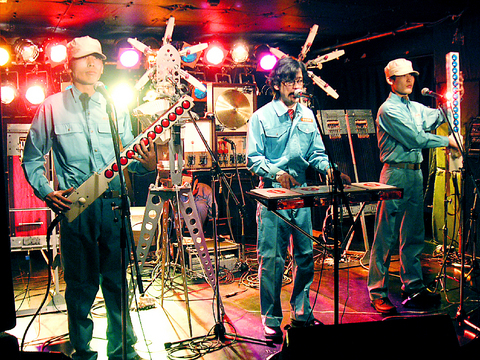In the past three weeks over 100,000 visitors have flocked to the Taipei Fine Arts Museum for the Vivienne Westwood fashion exhibition, creating long queues and an overwhelming feeling of excitement inside its sparse modernist-style interior spaces.
However, for those of you wanting a deeper involvement with art, rather than an experience akin to browsing chic department store windows, then the B!AS International Sound Art Exhibition is for you.
What exactly is sound art? Is it music? Is it installation art? As one of the exhibiting artists Christina Kubisch said, sound art begins with people such as avant-garde composers John Cage and Pauline Olivieros. Contemporary media artists Wang Jun-Jieh (

PHOTO COURTESY OF TFAM
Besides never-before-seen classic pieces of sound installation and audio-visuals, there are works selected by an international sound art competition sponsored by the Yageo Foundation. Some of the works are interactive such as Marc Behren's Tokyo Circle, in which the weight of your footsteps controls the sounds that are emitted from the circular platform.
Kubisch said that not only is sound art time-based, meaning that you need time to experience and to listen to each of the works, but that you see things differently when you listen with attention.
Her electro-magnetic installation
Bird Tree consists of a flowing pattern of green wires drawn on the wall. Donning headphones, you can then pick up the sounds of various birds and nature sounds that tend to get louder the closer you get to the wall. The work makes the viewer become a participant in that it is necessary to walk around to pick up all the sounds that are emitted.
Paul DeMarinis' Fireflies Alight on the Abacus of Al-Farabi is a sound/laser installation in which the sound waves make small loops of wire flutter in the light of a green laser. The installation lets you see the sound of waves, rather than just listen to them.
In one darkened room, several projections correspond with various sound pieces that range in feeling from techno to the esoteric. The room is absolutely quiet, as one must wear individual headphones to hear the work.
One of the highlights of the show was the opening performance by the campy Japanese group Maywa Denki (
The YAGEO Sound Art Prize winning works are included in the exhibition and are notable for being the works of up and coming local artists.
First prize went to Hong Kongs' Anson, Hoi Shan Mak (
What: B!AS International Sound Art Exhibition
Where: Taipei Fine Arts Museum,181, Zhongshan North Road, Section 3, Taipei (台北市中山北路3段181號)
Telephone: (02) 2595 7656
When: Until Nov. 20

In Taiwan there are two economies: the shiny high tech export economy epitomized by Taiwan Semiconductor Manufacturing Co (TSMC, 台積電) and its outsized effect on global supply chains, and the domestic economy, driven by construction and powered by flows of gravel, sand and government contracts. The latter supports the former: we can have an economy without TSMC, but we can’t have one without construction. The labor shortage has heavily impacted public construction in Taiwan. For example, the first phase of the MRT Wanda Line in Taipei, originally slated for next year, has been pushed back to 2027. The government

July 22 to July 28 The Love River’s (愛河) four-decade run as the host of Kaohsiung’s annual dragon boat races came to an abrupt end in 1971 — the once pristine waterway had become too polluted. The 1970 event was infamous for the putrid stench permeating the air, exacerbated by contestants splashing water and sludge onto the shore and even the onlookers. The relocation of the festivities officially marked the “death” of the river, whose condition had rapidly deteriorated during the previous decade. The myriad factories upstream were only partly to blame; as Kaohsiung’s population boomed in the 1960s, all household

Allegations of corruption against three heavyweight politicians from the three major parties are big in the news now. On Wednesday, prosecutors indicted Hsinchu County Commissioner Yang Wen-ke (楊文科) of the Chinese Nationalist Party (KMT), a judgment is expected this week in the case involving Hsinchu Mayor Ann Kao (高虹安) of the Taiwan People’s Party (TPP) and former deputy premier and Taoyuan Mayor Cheng Wen-tsan (鄭文燦) of the Democratic Progressive Party (DPP) is being held incommunicado in prison. Unlike the other two cases, Cheng’s case has generated considerable speculation, rumors, suspicions and conspiracy theories from both the pan-blue and pan-green camps.

Stepping inside Waley Art (水谷藝術) in Taipei’s historic Wanhua District (萬華區) one leaves the motorcycle growl and air-conditioner purr of the street and enters a very different sonic realm. Speakers hiss, machines whir and objects chime from all five floors of the shophouse-turned- contemporary art gallery (including the basement). “It’s a bit of a metaphor, the stacking of gallery floors is like the layering of sounds,” observes Australian conceptual artist Samuel Beilby, whose audio installation HZ & Machinic Paragenesis occupies the ground floor of the gallery space. He’s not wrong. Put ‘em in a Box (我們把它都裝在一個盒子裡), which runs until Aug. 18, invites